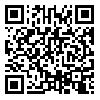
Journal of Modern Research Physics

Volume 4, Issue 2 (Autumn & Winter 2020)
JMRPh 2020, 4(2): 1-14 |
Back to browse issues page
Download citation:
BibTeX | RIS | EndNote | Medlars | ProCite | Reference Manager | RefWorks
Send citation to:



BibTeX | RIS | EndNote | Medlars | ProCite | Reference Manager | RefWorks
Send citation to:
Eskandari V, sharifi N. Enhanced Molecular Vibrations of Phenylalanine, Beta-alanine, Leucine and Glycine Amino Acids Using Ag Nanoparticles for Their Detection. JMRPh 2020; 4 (2) :1-14
URL: http://jmrph.khu.ac.ir/article-1-98-en.html
URL: http://jmrph.khu.ac.ir/article-1-98-en.html
University of Kashan
Abstract: (1641 Views)
Ag nanoparticles were deposited using the chemical method of Tollens to have silvery active substrates which they were utilized in Surface Enhanced Raman Spectroscopy (SERS) to detect phenylalanine, beta-alanine, leucine and glycine amino-acids. Silvery active SERS substrates were characterized using UV-Vis spectroscopy, X-ray diffraction (XRD) and field emission scanning electron microscopy (FE-SEM). Plasmonic peak at around 439 nm in UV-Vis spectrum as well as FCC structure in XRD spectrum confirmed the formation of Ag structures. According to the FE-SEM image, although the most Ag particles have the sizes between 100 - 300 nm, particles with the smaller size of 50 nm and the larger size of 1000 nm have been synthesized. The presence of the large particles causes the light scatters from them. Then, different concentrations of the amino acids were engraved on the active SERS substrates to detect their molecular vibrations using Raman spectroscopy. The molecular vibrations of the amino acids are enhanced when they were engraved on the active SERS substrates due to surface plasmon resonance of the smaller Ag nanoparticles as well as light scattering from the larger Ag particles. In the other hand, the SERS intensity of the amino acids are stronger than their Raman intensity. The active SERS substrates could identify the concentration of 10-7 M of the amino-acids.
Keywords: Surface Enhanced Raman Spectroscopy (SERS), Amino acids, Phenylalanine, Beta-alanine, Leucine, glycine.
Type of Study: Research |
Subject:
Special
Received: 2019/06/2 | Accepted: 2020/09/20 | Published: 2021/02/8 | ePublished: 2021/02/8
Received: 2019/06/2 | Accepted: 2020/09/20 | Published: 2021/02/8 | ePublished: 2021/02/8
Send email to the article author
| Rights and permissions | |
 |
This work is licensed under a Creative Commons Attribution-NonCommercial 4.0 International License. |



